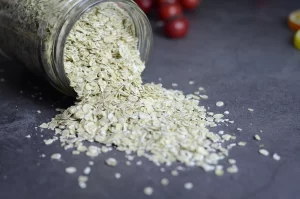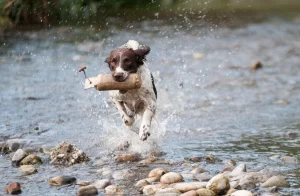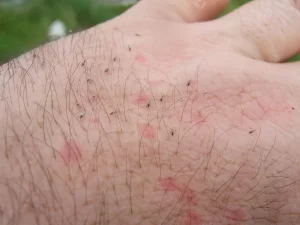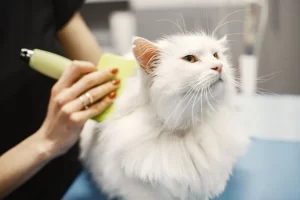Dog scooting refers to when a dog drags its bottom along the ground using its hind legs. This behavior can be caused by a number of issues, including anal glands that are full or infected, irritation or itching in the anal area, or worms. It can also be a sign of a more serious medical condition. Home remedies for dog scooting include expressing the dog’s anal glands, cleaning the anal area with a warm washcloth, and adding omega-3 fatty acids to the dog’s diet. However, if the scooting persists or is accompanied by other symptoms, it is important to consult a veterinarian to rule out any underlying medical conditions.
If you prefer to listen on-the-go, be sure to check out the audio version of this blog below!
Table of Contents
ToggleMain symptoms of dog scooting
The main symptom of dog scooting is when a dog drags its bottom along the ground using its hind legs. Other symptoms that may be associated with scooting include:
- Itching or irritation in the anal area
- Licking or biting at the anal area
- Redness or swelling around the anus
- Discharge or bleeding from the anus
- A strong, unpleasant odor coming from the anus
- Constipation or diarrhea
- Excessive licking of the hind legs
- Signs of discomfort or pain when the area is touched
Here is an example of a dog scooting on the floor.
It is important to note that these symptoms can also be caused by other issues, such as an infection or parasites like UTI which can happen in male or female dogs, so it is always best to consult a veterinarian for a proper diagnosis and treatment.
Main causes of dog scooting
Main symptoms of dog scooting are:
- Full or infected anal glands: Anal glands are small sacs located near the anus that produce a smelly, oily substance used for marking territory. When these glands become full or infected, they can cause discomfort and lead to scooting behavior.
- Irritation or itching in the anal area: Dogs may scoot as a way to relieve itching or discomfort in the anal area caused by skin allergies, flea or tick infestations, or other types of dermatitis.
- Worms: Dogs with worms, such as tapeworms or roundworms, may scoot as a way to relieve the itching caused by the worms’ presence in the intestinal tract.
- Gastrointestinal issues: Dogs with gastrointestinal issues, such as diarrhea or constipation, may scoot as a way to alleviate discomfort caused by these conditions.
- Proctitis: Proctitis is an inflammation of the rectum and anus, which can lead to discomfort and scooting.
- Perianal fistulas: Perianal fistulas are small, painful sores that develop around the anus and can lead to scooting.
- Rectal prolapse: Rectal prolapse is a condition in which the rectum protrudes through the anus, which can cause discomfort and scooting behavior. Some prolapse can be treated at home using natural and home remedies.
- Tumors: Tumors in or around the anus can cause discomfort and lead to scooting.
- Trauma: Injuries to the anus or rectum can cause discomfort and lead to scooting.
- Behavioral issues: In some cases, scooting may be a behavioral issue, rather than a medical one. Dogs may scoot as a way to get attention or because they are anxious or stressed
It’s important to note that some of these causes may have overlapping symptoms and It’s important to consult a veterinarian for a proper diagnosis and treatment.

Home remedies used for dog scooting
- Expressing the anal glands: If your dog’s scooting is caused by full or impacted anal glands, you can try expressing the glands at home. This should only be done with the guidance of a veterinarian, as improper technique can cause injury or pain.
- Warm compress: Applying a warm compress to the anal area can help to relieve discomfort and swelling. To make a warm compress, soak a clean washcloth in warm water, wring it out, and apply it to the area for 10-15 minutes at a time.
- Omega-3 fatty acids: Adding omega-3 fatty acids to your dog’s diet can help to reduce inflammation and itching in the anal area. Omega-3 fatty acids can be found in fish oil supplements, flaxseed oil, or certain types of fish.
- Coconut oil: Applying a small amount of coconut oil to the anal area can help to soothe itching and reduce inflammation.
- Apple cider vinegar: Dilute apple cider vinegar in water and use it to clean the anal area, or add it to your dog’s drinking water. It can help to reduce inflammation and itching.
- Aloe vera: Aloe vera gel can be applied to the anal area to soothe itching and reduce inflammation.
- Baking soda: Mix baking soda with water to make a paste and apply it to the anal area to help soothe itching.
- Oatmeal: Oatmeal can be added to your dog’s bathwater to help soothe itching and reduce inflammation.
- Witch hazel: Dilute witch hazel in water and use it to clean the anal area or apply it with a cotton ball to help soothe itching.
- Chamomile: Chamomile tea can be used to make a compress and applied to the anal area to soothe itching.
- Green tea: Green tea can be used to make a compress and applied to the anal area to soothe itching.
- Potato: Cut a potato into slices and apply it to the anal area to reduce itching.
- Turmeric: Add a pinch of turmeric to your dog’s food to help reduce inflammation and itching.
- Alum: Mix a small amount of alum powder with water to make a paste and apply it to the anal area to help soothe itching.
- Epsom Salt: add Epsom salt to your dog’s bathwater to help soothe itching and reduce inflammation.
It’s important to note that these home remedies are not a substitute for proper veterinary care, and they should be used in addition to, and not instead of, your veterinarian’s recommendations. If your dog’s scooting persists or is accompanied by other symptoms, it is important to consult a veterinarian to rule out any underlying medical conditions.
How to express the anal glands of scooting dog?
Expressing the anal glands of a dog is a procedure that should only be done by a veterinarian or a trained professional. If your dog’s scooting is caused by full or infected anal glands, your vet may express the glands manually to relieve the pressure and discomfort. Here is a general step by step on the process of expressing the anal glands:
- The dog is placed on its side or in a standing position.
- The veterinarian or trained professional will locate the anal glands by feeling for them on either side of the anus.
- They will then gently squeeze the gland, expressing the fluid inside.
- The expressed fluid should be checked for color, consistency, and odor, as any abnormalities may indicate an infection.
- The area should be cleaned with a damp cloth or surgical scrub solution.
- The procedure should be repeated on the other side.
It’s important to note that expressing the anal glands at home is not recommended as improper technique can cause injury or pain to the dog, and it’s important to consult with a veterinarian to determine the appropriate frequency of expressing the anal glands. It’s also important to monitor your dog’s behavior after the procedure to see if there’s any improvement in the scooting and if the scooting continues, to consult the vet again.
Proper diets for the scooting dog
A healthy diet that is rich in omega-3 fatty acids can help to reduce inflammation and itching in the anal area, which may help to relieve scooting. Some examples of foods that are high in omega-3 fatty acids include:
- Fish: Fish such as salmon, sardines, and anchovies are high in omega-3 fatty acids. You can add canned fish to your dog’s food or give them small amounts of cooked fish as a treat.
- Flaxseed: Flaxseed oil and ground flaxseed are rich in omega-3 fatty acids. You can add a small amount of flaxseed oil to your dog’s food or sprinkle a small amount of ground flaxseed over their food.
- Chia seeds: Chia seeds are also high in omega-3 fatty acids. You can add a small amount of chia seeds to your dog’s food or make a chia seed gel by mixing chia seeds with water.
- Pumpkin seeds: Pumpkin seeds are high in omega-3 fatty acids, zinc, and magnesium. You can crush the pumpkin seeds and add them to your dog’s food.
- Eggs: Eggs contain omega-3 fatty acids, and can be given to your dog as a treat or added to their food.
- Spinach: Spinach is high in antioxidants, vitamins, and minerals and is also a good source of omega-3 fatty acids. You can add spinach to your dog’s food.
It’s important to consult with your veterinarian before making any significant changes to your dog’s diet. They can provide recommendations that are specific to your dog’s needs and help ensure that they are getting the right balance of nutrients. It’s also important to note that these diet options should be used in addition to, and not instead of, your veterinarian’s recommendations.

Is a lack of physical activity a potential cause of scooting in dogs?
Scooting behavior in dogs can stem from various underlying causes, such as impacted or infected anal glands, anal irritation or itchiness, gastrointestinal issues, parasitic infections, and specific medical conditions. In certain scenarios, a lack of physical activity can also factor into the equation.
For instance, insufficient physical activity can lead to weight gain and obesity in dogs. This excess weight exerts added pressure on their anal glands, potentially resulting in scooting. Moreover, a sedentary lifestyle can contribute to constipation, leading to discomfort and, in turn, scooting episodes.
It’s important to clarify that while low physical activity is not a direct instigator of scooting, it can exacerbate the risk in specific instances. Thus, ensuring your dog receives regular exercise and maintains a healthy weight is vital to mitigate the likelihood of scooting episodes. If your dog displays scooting behavior, it is advisable to consult with your veterinarian to rule out underlying medical conditions. Your veterinarian will provide expert guidance on the most suitable course of action for your dog’s specific circumstances.
Can an increase in water intake alleviate scooting in dogs?
Drinking more water can help to alleviate scooting in certain situations. If a dog is dehydrated, it can lead to constipation, which can cause discomfort and scooting. By drinking more water, the dog’s stools will become softer, making it easier for them to pass, which can help to relieve discomfort and scooting.
Additionally, drinking more water can help to flush toxins out of the body, which can help to reduce inflammation and itching in the anal area. This can also help to prevent infections and other issues that can cause scooting.
It’s important to note that increasing water intake alone may not be enough to alleviate scooting if there is an underlying medical condition causing it. It’s important to consult your veterinarian if you notice your dog scooting and to rule out any underlying medical conditions. Your vet will be able to advise on the best course of action, including how much water your dog needs and what diet is appropriate for your dog.
Methods for encouraging a dog to drink more water and increase physical activity
Forcing a dog to drink more water or be more physically active can be difficult and may not be the best approach. Dogs, like humans, have their own preferences and habits, and forcing them to do something they don’t want to do can lead to stress and anxiety.
Here are some ways you can encourage your dog to drink more water:
- Make sure that the water bowl is always full and clean.
- Place water bowls in different areas of the house, so your dog can easily access water.
- Add a small amount of low-sodium chicken or beef broth to the water to make it more appealing.
- Offer ice cubes to help keep the water cooler and more appealing.
- Consider getting a water fountain, which can encourage your dog to drink more water.
To encourage your dog to be more physically active:
- Start with shorter walks or play sessions, and gradually increase the duration and intensity over time.
- Find an activity that your dog enjoys, such as fetch or agility training.
- Play with your dog regularly and make it a consistent routine.
- Take your dog to a dog park or doggy daycare, where they can socialize and play with other dogs.
- Consider hiring a professional dog walker or dog trainer to provide additional exercise and activity for your dog.

Things to do and not to do when your dog is scooting
Things to do when your dog is scooting:
- Consult a veterinarian: It’s important to have your dog examined by a vet to determine the underlying cause of the scooting and to get a proper diagnosis and treatment plan. How often should you visit a vet? Check out our suggestions and guide here.
- Follow the veterinarian’s instructions: If your dog is prescribed medication or other treatments, it’s important to follow the instructions carefully and keep all follow-up appointments.
- Clean the anal area: If your dog’s scooting is caused by an infection or inflammation, it’s important to keep the area clean by gently wiping it with a warm, damp cloth.
- Provide a healthy diet: A healthy diet that is rich in omega-3 fatty acids can help to reduce inflammation and itching.
- Keep an eye on the dog’s behavior: Observe your dog’s behavior to see if you can identify any patterns or triggers that may be associated with the scooting.
Things to avoid when your dog is scooting:
- Ignoring the problem: Scooting may be a sign of a more serious underlying condition, so it’s important not to ignore it.
- Using human medications: Never give your dog any medications without consulting a veterinarian first. Some human medications can be toxic to dogs.
- Scolding or punishing your dog: Scooting is not a behavioral issue, it’s a medical one, so scolding or punishing your dog will not help.
- Using harsh chemicals to clean the area: Harsh chemicals can further irritate the skin and make the problem worse, so always use a mild, non-irritating cleanser or just warm water.
- Not observing the dog’s behavior: Not observing your dog’s behavior can lead to not identifying patterns or triggers that may be associated with the scooting, which could help to prevent it in the future.
When is the time to visit the Vet?
It’s important to visit the vet if you notice your dog scooting, as it may be a sign of an underlying medical condition. Here are some situations where you should seek veterinary attention as soon as possible:
- If your dog’s scooting is accompanied by other symptoms such as vomiting, diarrhea, or loss of appetite, it may be a sign of a more serious underlying condition and should be evaluated by a vet.
- If your dog’s scooting is accompanied by blood or discharge from the anus, it could indicate an infection or injury and should be evaluated by a vet.
- If your dog’s scooting persists or gets worse despite home treatments, it could indicate a more serious underlying condition and should be evaluated by a vet.
- If your dog’s scooting starts suddenly, or if your dog is older or has a pre-existing condition, it’s important to consult with a veterinarian to rule out any underlying medical conditions and to get a proper diagnosis and treatment plan.
- If your dog’s scooting is caused by an infection or inflammation, your vet may prescribe antibiotics or anti-inflammatory medications.
It’s important to remember that scooting can be caused by a variety of factors and it’s important to consult a veterinarian for a proper diagnosis and treatment. And it’s always better to be safe than sorry, if you have any doubts or concerns, it’s better to consult your vet.
Medical treatment of dog scooting
Treatment for dog scooting will depend on the underlying cause of the behavior. Some common treatments include:
- Expressing the anal glands: If the scooting is caused by full or infected anal glands, your vet may express the glands manually to relieve the pressure and discomfort.
- Medications: If the scooting is caused by an infection or inflammation, your vet may prescribe antibiotics or anti-inflammatory medications.
- Deworming: If the scooting is caused by worms, your vet may prescribe a deworming medication to kill the worms and relieve the itching.
- Allergy treatment: If the scooting is caused by an allergic reaction, your vet may prescribe a medication or recommend an elimination diet to determine the allergen, and then eliminate it from your dog’s diet.
- Surgery: In some cases, surgery may be necessary to correct certain conditions that may cause scooting, such as tumors or perianal fistulas.
- Behavioral therapy: If the scooting is a behavioral issue, your vet may recommend behavior modification or anti-anxiety medication.
It’s important to note that the treatment of scooting can be complex and may require more than one type of therapy. The medications prescribed by your veterinarian may vary depending on the underlying cause of the scooting.
It’s important to follow the veterinarian’s instructions and keep all follow up appointments, to ensure that your dog’s condition is under control.
What Are Dog Anal Glands?
Dog anal glands, also called sacs or scent glands, are small glands located on either side of the anus. They produce a strong-smelling, oily substance that is used for marking territory. The substance is expelled when a dog defecates and can also be used as a way of communicating with other dogs. The substance is normally squeezed out of the glands during bowel movements, but in some dogs, the glands may become clogged or infected and require manual expression by a vet.
Anal glands can become a problem if they become clogged, infected, or impacted. This can cause discomfort, pain, and scooting behavior, and if left untreated, it can lead to abscesses or infections. In some cases, the glands may need to be removed surgically if they become chronically infected or impacted.
Which dog breeds are more prone to dog scooting?
All dogs can develop the behavior of scooting, but certain breeds may be more prone to it due to their anatomy. For example, breeds with short, narrow muzzles, such as Bulldogs and Pugs, are more likely to have issues with their anal glands, which can lead to scooting. Additionally, breeds with long, thick coats, such as Shih Tzus and Lhasa Apsos, may be more susceptible to skin irritation and itching in the anal area, which can also cause scooting.
Other breeds that have a history of having anal gland issues are:
- Boston Terrier
- Boxer
- Cocker Spaniel
- Pomeranian
- Basset Hound
- Beagle
- German Shephard
- Labrador Retriever
It’s important to note that any dog can develop issues with their anal glands or itchy skin, regardless of breed. It’s important to pay attention to your dog’s behavior and consult a vet if you notice any symptoms of scooting or discomfort around their anus area.

Should I be worried if my dog is scooting?
Scooting can be a sign of an underlying medical condition and should be evaluated by a veterinarian. It’s important to consult a veterinarian if your dog is scooting, as it may be a sign of an issue with the anal glands, worms, or other gastrointestinal issues. In some cases, scooting may also be caused by an allergic reaction, a skin condition, or a behavioral issue.
However, it’s important to note that some dogs may scoot occasionally without any underlying medical conditions. For example, some dogs may scoot after eating grass or other foreign objects, or if they get something stuck in their anal area.
It’s always good to consult your veterinarian if you notice your dog scooting, to rule out any underlying medical conditions. Your veterinarian will be able to advise on the best course of action, including any necessary treatment or follow-up care.
In any case, it’s important to observe your dog’s behavior and to note if there’s any change in their scooting behavior, if it persists, becomes more frequent, or is accompanied by other symptoms, it’s important to seek veterinary attention as soon as possible.
Does a dog scooting mean worms?
Worms can be one of the causes of scooting in dogs. If a dog has worms, they may experience itching and discomfort in the anal area, which can lead to scooting. Some types of worms that can cause scooting include roundworms, tapeworms, and hookworms. These worms can be contracted through contact with infected feces, or by ingesting infected prey, such as mice or birds.
The symptoms of worm infestation can vary depending on the type of worm and the number of worms present. Common symptoms include diarrhea, vomiting, weight loss, a dull coat, and scooting. In some cases, the worms may be visible in the dog’s feces or around the anus.
If you suspect that your dog has worms, it’s important to take them to a veterinarian for a proper diagnosis and treatment. A veterinarian will be able to diagnose worms through a fecal examination, and they can prescribe the appropriate deworming medication.
It’s important to note that scooting is not always caused by worms, and it can have multiple causes like anal glands issues, gastrointestinal problems, skin conditions, allergies and more. So it’s important to consult your veterinarian to rule out any underlying medical conditions and to get a proper diagnosis and treatment plan.
References:
- Why Is My Dog Scooting?, www.akc.org
- Dog Scooting: Why It Happens and What to Do About It, www.PetMD.com
- Corbee RJ, Woldring HH, van den Eijnde LM, Wouters EGH. A Cross-Sectional Study on Canine and Feline Anal Sac Disease. Animals (Basel).
- Bergeron CC, Costa MC, de Souza LB, Sauvé F. Description of the bacterial microbiota of anal sacs in healthy dogs. Can J Vet Res. 2021 Jan;85(1):12-17.














